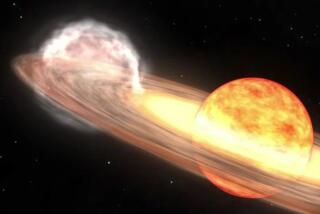Planets Are the Stars of This Week’s Late Show
- Share via
If you got a new telescope over the holidays, there is plenty to see in the night sky in the coming week.
Unfortunately, the moon, one of the first objects fledgling astronomers try to view, is a waning crescent in the predawn sky and won’t return to the evening sky until Jan. 4. But Saturn and Jupiter are readily visible.
You can see Saturn as soon as it gets dark by facing east and looking for a dominant “star” about 20 degrees above the eastern horizon. Saturn is especially bright now, outshining all the stars in that part of the sky because of three geometric effects: The planet is near the closest point to the sun in its 29-year orbit, Earth and Saturn are particularly close together (only 750 million miles apart) and the planet is tipped toward us at its maximum angle, showing its rings to their fullest extent.
Jupiter is now about five times brighter than Saturn, and it will climb above the east-northeast horizon a little later in the evening. With a 100-power telescope, you should be able to make out the dusky bands girdling Jupiter’s midsection. With a more powerful scope, you should be able to make out the great red spot, which has been pale in recent years.
More to Read
Sign up for The Wild
We’ll help you find the best places to hike, bike and run, as well as the perfect silent spots for meditation and yoga.
You may occasionally receive promotional content from the Los Angeles Times.






